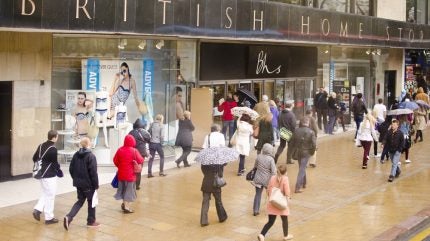
UK retail footfall saw a year-on-year decline in May 2024, according to the latest BRC-Sensormatic IQ data.
Despite this overall drop, there was a noticeable month-on-month improvement across all shopping destinations, offering a glimmer of hope for retailers.

Discover B2B Marketing That Performs
Combine business intelligence and editorial excellence to reach engaged professionals across 36 leading media platforms.
High streets and retail parks show slight recovery
High Street footfall decreased by 2.7% year-on-year in May, an improvement from the 6.9% drop seen in April. Similarly, Retail Parks experienced a 2.3% year-on-year decrease, up from a 6.2% decline in the previous month.
Shopping Centres also followed this trend, with a 4.5% year-on-year fall in footfall, compared to a 7.2% decrease in April.
Regional footfall trends
All UK nations experienced a fall in footfall compared to last year. Northern Ireland recorded the smallest decline at 3.0%, followed by England at 3.4%. Wales and Scotland saw more significant decreases, at 5.0% and 5.4% respectively.
Among major cities, Birmingham showed a positive trend in footfall, standing out as a beacon of hope for other urban centres.

US Tariffs are shifting - will you react or anticipate?
Don’t let policy changes catch you off guard. Stay proactive with real-time data and expert analysis.
By GlobalDataPolitical action needed
Helen Dickinson, Chief Executive of the British Retail Consortium, highlighted the need for political intervention. “UK footfall declined in May, as bank holidays and improving weather failed to entice customers to make in person trips to shopping destinations,” she stated.
She emphasised the importance of political parties formulating plans to rejuvenate footfall, especially with an upcoming election. “A broken business rates system and outdated planning laws are holding back the industry.
Politicians of all stripes must address these issues to boost economic growth, lift consumer spirits, and help drive more shoppers back to our high streets and other retail destinations.”
Cautious optimism ahead
Despite the year-on-year decline, Andy Sumpter, Retail Consultant EMEA for Sensormatic Solutions, noted some positive signs. He mentioned, “Retailers were dealt some good news in May, as footfall recovered against the month before.
While no one’s denying this improvement is starting from a low base following a gloomy performance in April, many will be hoping that this represents a turning point.”
Sumpter pointed to easing inflationary pressures and the upcoming European Football Championships and Olympics as potential catalysts for increased shopper turnout.
Retailers remain cautiously optimistic, hoping that these positive signs indicate a broader recovery trend. With political support and favourable economic conditions, the UK retail sector could see a significant boost in the coming months.
Proposed measures for support
The BRC has outlined several key areas where political support could make a significant difference:
- Financial Aid and Grants: Direct financial assistance to struggling retailers to help cover operational costs and prevent closures.
- Business Rate Reform: Revisiting the current business rate system to ensure it is fair and supportive of brick-and-mortar stores, which are disproportionately affected compared to online retailers.
- Investment in Infrastructure: Enhancing the attractiveness of town centers through improved infrastructure, better transport links, and more appealing public spaces.
- Consumer Confidence Campaigns: Initiatives to boost consumer confidence and encourage spending, such as promotional events, public information campaigns, and support for local businesses.
- Support for Innovation: Encouraging retailers to innovate and adapt by providing funding for digital transformation and the integration of new technologies.





